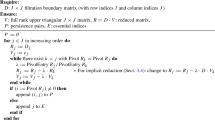Abstract
A multi level approach to synthesis of planar mechanisms is presented. The approach covers both structural and dimensional synthesis of planar rigid body mechanisms containing revolute and translational joints. The synthesis is based on four different criteria. Firstly the type of mechanism is chosen with a view to get the simplest mechanism that satisfactorily fulfills the remaining three criteria. Two of these criteria are formulated as constraints on the kinematic behavior and the total area occupied by the mechanism, respectively. The fourth criteria is simply the desired minimization of the reactive forces/moments that appear in the mechanism. The desired kinematic behavior is based on a finite number, typically 1, ..., 6, of points in time (positions of the mechanism) where the position and orientation of up to two output bodies may be prescribed. The constraints on occupied areas are labelled territory constraints and formulated as a number of restricted areas (boxes). A synthesis is automatically performed at five levels. At the first level the structure of the mechanism is decided. At the second level initial dimensions for the given type of mechanism are found by random checking. At the third level the constraints on the kinematic behavior is fulfilled. At the fourth level the territory constraints are taken into account and, finally, at the fifth level the minimization of reactions is carried out. The entire approach has been implemented in a software package SYNMEC that runs on PCs and constitutes a way of performing the synthesis of a mechanism that is general and flexible with respect to both the type of mechanism that may be synthesized as well as the desired behavior upon which the synthesis is based.
Similar content being viewed by others
References
Conte, F.L., George, G. R., Mayne, R. W., and Sadler, J. P., ‘Optimum mechanism design combining kinematic and dynamic-force considerations’,Journal of Engineering for Industry 97, 1975, 662–670.
Fox, R. L. and Willmert, K. D., ‘Optimum design of curve-generating linkages with inequality constraints’,Journal of Engineering for Industry 89, 1967, 144–152.
Garrett, R. E. and Hall, A. S., ‘Optimal synthesis of randomly generated linkages’,Journal of Engineering for Industry 90, 1968, 198–203.
Hansen, M. R., ‘Development and implementation of methods for analysis and synthesis of mechanical mechanisms’, Ph.D. Thesis, Institute of Mechanical Engineering, Aalborg University, 1992.
Kakatsios, A. J. and Tricamo, S. J., ‘Design of planar rigid body guidance mechanisms with simultaneously optimized kinematic and dynamic characteristics’, inDesign Engineering Technical Conference, Ohio, 1986.
Soni, A. H., Dado, M. H. F., and Weng, Y., ‘An automated procedure for intelligent mechanism selection and dimensional synthesis’,Journal of Mechanism, Transmission, and Automation in Design 110, 1988, 130–137.
Author information
Authors and Affiliations
Rights and permissions
About this article
Cite this article
Hansen, M.R. A multi level approach to synthesis of planar mechanisms. Nonlinear Dyn 9, 131–146 (1996). https://doi.org/10.1007/BF01833297
Received:
Accepted:
Issue Date:
DOI: https://doi.org/10.1007/BF01833297




